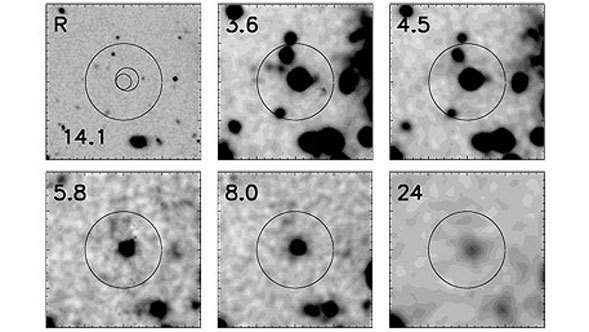
Credit: NASA/JPL-Caltech/M. Ashby (Harvard-Smithsonian CfA)
Observation • March 31st, 2006 • sig06-007
sig06-007
This series of deep images shows the small field surrounding the brightest SCUBA galaxy (CUDSS 14.1) in this study at six wavelengths. From left to right, these images were taken at, first, R band using the Subaru telescope, then 3.6, 4.5, 5.8, and 8.0 microns using IRAC, and finally at 24 microns using MIPS. The circle shows the area searched for potential counterparts to the SCUBA galaxy. At 3.6 and 4.5 microns there are multiple candidates. At visible wavelengths, the SCUBA galaxy is invisible -- presumably because it is screened by thick clouds of dust generated by the very rapid star formation ongoing within it. But at long wavelengths there is only one candidate -- a strong source of emission at 5.8, 8.0 and 24.0 microns easily detected by Spitzer. This demonstrates how foreground galaxies, such as the bright object just left of bottom center in the R-band image, fade from view toward ever-longer wavelengths. This underlines the benefits of Spitzer observations for the continuing study of these enigmatic, high-redshift galaxies.
About the Object
- Name
- SCUBA Galaxy • CUDSS 14.1
- Type
- Galaxy > Activity > Starburst
- Distance
- 10,000,000,000 Light Years
- Redshift
- 2
Color Mapping
| Band | Wavelength | Telescope |
| Optical | 700 nm | |
| Infrared | 3.6 µm | Spitzer IRAC |
| Infrared | 4.5 µm | Spitzer IRAC |
| Infrared | 5.8 µm | Spitzer IRAC |
| Infrared | 8.0 µm | Spitzer IRAC |
| Infrared | 24.0 µm | Spitzer MIPS |





